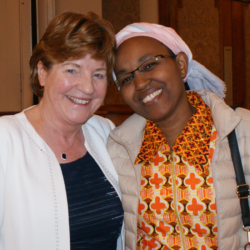
Dr. Ruth Patterson brought a vibrant and hope-filled message to men and women religious, gathered in the Tara Centre, Omagh on Sunday, October 12, 2014, as she looked to the ‘outrageous hope’ religious can be for today’s world if we can truly acknowledge and witness to the reign of God in our midst.
Acknowledging the current reality for Religious – the weight of declining numbers, lack of vocations, general lack of interest in matters of faith, the inability to do today what we did very well in the past, Ruth offered the Gospel story of Jesus’ encounter with Martha and Mary following the death of their brother Lazarus. Into a situation of great distress and disappointment: ‘Lord, if you had been here, my brother would not have died’, Jesus draws Martha into a recognition of the nearness of God to her in her grief. In the ensuing dialogue, her spirit begins to soar and she can see beyond present sorrow, ‘Yes Lord, I believe…’. In Martha’s words to her sister Mary, ‘the Master is here and wants to see you’, she exudes a new confidence as she realises that God is in all that is happening, far beyond what the human heart can fathom.
This short phrase, ‘the Master is here and wants to see you’, was a mantra which Ruth drew on throughout her presentation as she invited her audience to allow that life-giving, hope creating message to sink in. She invited us to rest in the gaze of that unconditional, limitless, infinite love in which we live and move and have our being, reminding us of the many instances in the Hebrew Scriptures where the nearness of God to His people was palpable. Hagar is affirmed in her identity ‘I have now seen the One who sees me’ (Gen.16:13). To Moses, Yahweh revealed himself as ‘I am…this is my name forever’ (Ex. 3:14, 15) the faithful One leading people from slavery to freedom. Martha and Mary have experienced in Jesus the presence of life and resurrection amidst death. This is the good news that we are called to share with others as together we vision and live into a new future that truly witnesses to the reign of God among God’s people.
Keeping commitment with this call, offering encouragement to others from our own place of vulnerability demands that we ‘allow our beliefs to find wings to soar beyond present darkness.’ It requires that we risk letting go of pre-conceived notions, and begin to see with new eyes. Ruth pointed to Simeon and Anna as two people who best display that gift of patient waiting. People of long experience and wisdom, and rooted and grounded in God, they kept hope alive, their spirits on tip toe with expectancy. Despite all evidence to the contrary, they believed the messiah would come. While living in the shadows of old age, having no visible importance or relevance, they were shining lights in the upside down kingdom of God. And it was to them that the revelation was given. Their ‘outrageous hope’ can be gleaned in Simeon’s ‘Nunc Dimittis’ ; Anna added her praise, her faithfulness after sixty years exuding the vibrancy of her walk with God. From both there is a clear message that ‘the best is still to come’; all that had gone before is preparation for what is to come.
Living the prayer of ‘letting go’, of silence filled with vibrant expectancy, Ruth asked if religious, having this vision of expectant prayer, could contribute to a seismic shift in the unseen world. Could we allow ourselves to be really present to the One whose name is ‘I am’? Could we allow ourselves to be surprised by an extraordinary joy, and not lose faith through lack of awareness, or failure to keep vigil? Can we be bearers of hope announcing the dawning of a new age, showing by the way we live the first fruits of the new future we envision?
 Dr. Ruth Patterson
Dr. Ruth Patterson
Ruth left us with some questions to ponder:
Is my hope rooted and grounded in God?
Are my spirits on tip-toe with expectation?
Am I ready for the God of surprises?
Do I share hopes and dreams with others?
Can I see and declare that the best is yet to be?
Are we communities of outrageous hope?
Chris Hegarty rsm
Northern Province


